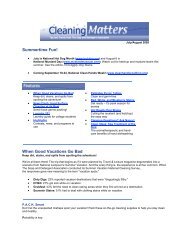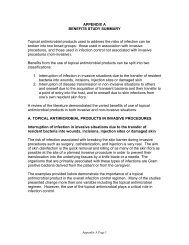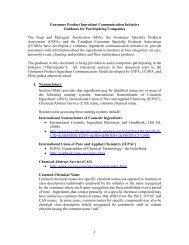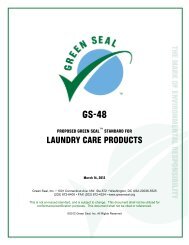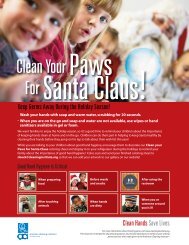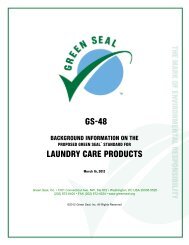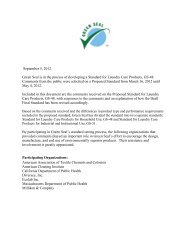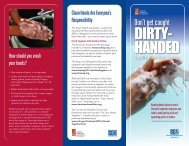subchapter c -- federal hazardous substances act regulations
subchapter c -- federal hazardous substances act regulations
subchapter c -- federal hazardous substances act regulations
You also want an ePaper? Increase the reach of your titles
YUMPU automatically turns print PDFs into web optimized ePapers that Google loves.
otherwise provided pursuant to section 3 of the<br />
<strong>act</strong>.<br />
(b) The following warning statement will<br />
be considered as meeting the requirements of<br />
section 2(p)(1) of the <strong>act</strong> (repeated in §<br />
1500.3(b)(14)(i)) if the only hazard associated<br />
with an article is that the contents are under<br />
pressure:<br />
WARNING—CONTENTS UNDER PRESSURE<br />
Do not puncture or incinerate container.<br />
Do not expose to heat or store at temperatures above<br />
120 °F. Keep out of the reach of children.<br />
A pr<strong>act</strong>ical equivalent may be substituted for<br />
the statement “Keep out of the reach of<br />
children.”<br />
(c) That portion of the warning statement<br />
set forth in paragraph (b) of this section in<br />
capital letters should be printed on the main<br />
(front) panel of the container in capital letters<br />
of the type size specified in § 1500.121(c).<br />
The balance of the cautionary statements may<br />
appear together on another panel if the front<br />
panel also bears a statement such as “Read<br />
carefully other cautions on _______ panel.”<br />
(d) If an article has additional hazards,<br />
such as skin or eye irritancy, toxicity, or<br />
flammability, appropriate additional front and<br />
rear panel precautionary labeling is required.<br />
§ 1500.133 Extremely flammable cont<strong>act</strong><br />
adhesives; labeling.<br />
(a) Extremely flammable cont<strong>act</strong><br />
adhesives, also known as cont<strong>act</strong> bonding<br />
cements, when distributed in containers<br />
intended or suitable for household use may be<br />
misbranded under the <strong>act</strong> if the containers fail<br />
to bear a warning statement adequate for the<br />
protection of the public health and safety.<br />
(b) The following warning statement is<br />
considered as the minimum cautionary<br />
labeling adequate to meet the requirements of<br />
section 2(p)(1) of the <strong>act</strong> (repeated in §<br />
1500.3(b)(14)(i)) with respect to containers of<br />
more than one-half pint of cont<strong>act</strong> adhesive<br />
and similar liquid or semiliquid articles having<br />
a flashpoint at or below 20 °F. as determined<br />
by the method in § 1500.43, when the only<br />
hazard foreseeable is that caused by the<br />
extreme flammability of the mixture:<br />
DANGER<br />
EXTREMELY FLAMMABLE<br />
VAPORS MAY CAUSE FLASH FIRE<br />
16 CFR Ch. II (1–1–05 Edition)—proposed modificication – 6/25/06<br />
Vapors may ignite explosively.<br />
Prevent buildup of vapors—open all windows and<br />
doors—use only with cross-ventilation.<br />
Keep away from heat, sparks, and open flame.<br />
Do not smoke, extinguish all flames and pilot lights,<br />
and turn off stoves, heaters, electric motors, and other<br />
sources of ignition during use and until all vapors are<br />
gone.<br />
Close container after use.<br />
Keep out of the reach of children.<br />
(c) The words that are in capital letters in<br />
the warning statement set forth in paragraph<br />
(b) of this section should be printed on the<br />
main (front) panel or panels of the container in<br />
capital letters of the type size specified in §<br />
1500.121(c). The balance of the cautionary<br />
information may appear together on another<br />
panel provided the front panel bears a<br />
statement such as “Read carefully other<br />
cautions on ____ panel,” the blank being filled<br />
in with the identification of the specific label<br />
panel bearing the balance of the cautionary<br />
labeling. It is recommended that a borderline<br />
be used in conjunction with the cautionary<br />
labeling.<br />
(d) If an article has additional hazards, or<br />
contains ingredients listed in § 1500.14 as<br />
requiring special labeling, appropriate<br />
additional front and rear panel precautionary<br />
labeling is required.<br />
(e) Since the Commission has issued a<br />
regulation banning under the Consumer<br />
Product Safety Act extremely flammable<br />
cont<strong>act</strong> adhesives covered by this labeling<br />
regulation (sec. 16 CFR part 1302), paragraphs<br />
(a), (b), (c) and (d) of this section are revoked<br />
as to the subject products after June 13, 1978.<br />
§ 1500.134 Policy on first aid labeling for<br />
saline emesis.<br />
(a) This section states the Consumer<br />
Product Safety Commission’s policy<br />
concerning first aid instructions for the use of<br />
a salt solution to induce vomiting (saline<br />
emesis) in the event of ingestion of <strong>hazardous</strong><br />
<strong>substances</strong>.<br />
(b) In many cases where <strong>hazardous</strong><br />
<strong>substances</strong> are ingested, the recommended first<br />
aid instructions for inducing vomiting have<br />
contained a statement that this should be<br />
accomplished by drinking a solution of salt<br />
(sodium chloride) in warm water. At one time,<br />
this direction was considered medically<br />
acceptable. However, the Commission has<br />
obtained information showing that the<br />
instruction to perform saline emesis is no<br />
-- 87 --<br />
Deleted: The word “CAUTION” may<br />
be substituted for the word<br />
“WARNING”.



